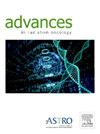Case Volume and Experience in Stereotactic Radiation: Analysis of a Prospective Peer Review Program
IF 2.7
Q3 ONCOLOGY
引用次数: 0
Abstract
Purpose
Stereotactic radiation therapy (SRT) is highly effective but carries the risk of significant toxicity. We identified factors associated with SRT plans that require revision in a comprehensive, prospective peer review program conducted across a network of affiliated radiation oncology centers.
Methods and Materials
Weekly peer review rounds were conducted to review SRT cases prior to the start of radiation. Revision recommendations were tracked. Univariate and multivariable logistic regression was performed to identify factors associated with case revision.
Results
From 2019 to 2024, 1172 SRT cases were reviewed at weekly rounds, including 313 brain stereotactic radiosurgery (SRS), 190 brain multi-fractionated SRS, and 669 stereotactic body radiation therapy. The yearly revision rate ranged from 19% in 2020 to 31% in 2024. There were 16 individual treating physicians with a median of 6 years of experience (range, 1-19 years), measured at the time of each SRT case review. Factors assessed for significance included SRT case volume in the 3 months preceding review (dichotomized as low- or high-volume), physician experience (≤2, 3-9, or ≥10 years), SRT technique (SRS, multi-fractionated SRS, or stereotactic body radiation therapy, and disease site. On multivariable logistic regression, revisions were less likely for high-volume physicians (odds ratio [OR], 0.58; 95% CI, 0.43-0.77), those with 3-9 years of experience (OR, 0.65; 95% CI, 0.44-0.96), and SRS technique (OR, 0.59; 95% CI, 0.41-0.84).
Conclusions
These data imply high value to prospective peer review for physicians with low SRT case volume and in their early career. Adequate case volume may be a critical factor for high quality SRT, analogous to the surgical literature. Annual revision rates in the program remained substantial over time, demonstrating the ongoing importance of an effective prospective peer review program for SRT.
立体定向放射的病例量和经验:一个前瞻性同行评议项目的分析
目的立体定向放射治疗(SRT)是一种非常有效的放射治疗方法,但具有明显的毒性风险。我们确定了与SRT计划相关的因素,这些因素需要在一个综合的、前瞻性的同行评审项目中进行修订,该项目在附属放射肿瘤学中心网络中进行。方法和材料每周进行同行评议,在放疗开始前对SRT病例进行评议。对修订建议进行了跟踪。采用单变量和多变量逻辑回归来确定与病例修订相关的因素。结果2019年至2024年,每周回顾1172例SRT病例,其中脑立体定向放射外科(SRS) 313例,脑多分割SRS 190例,体立体定向放射治疗669例。年修正率从2020年的19%到2024年的31%不等。在每个SRT病例回顾时,有16位治疗医生,平均经验为6年(范围1-19年)。评估显著性的因素包括回顾前3个月的SRT病例量(分为低量或高量)、医生经验(≤2年、3-9年或≥10年)、SRT技术(SRS、多分步SRS或立体定向体放射治疗)和疾病部位。在多变量logistic回归中,大容量医生(优势比[OR], 0.58; 95% CI, 0.43-0.77)、具有3-9年经验的医生(OR, 0.65; 95% CI, 0.44-0.96)和SRS技术(OR, 0.59; 95% CI, 0.41-0.84)的修订可能性较小。结论这些数据对低SRT病例量和职业生涯早期的医生的前瞻性同行评议具有很高的价值。足够的病例量可能是高质量SRT的关键因素,类似于外科文献。随着时间的推移,该项目的年度修订率保持了可观的水平,这表明了一个有效的前瞻性同行评审项目对SRT的持续重要性。
本文章由计算机程序翻译,如有差异,请以英文原文为准。
求助全文
约1分钟内获得全文
求助全文
来源期刊

Advances in Radiation Oncology
Medicine-Radiology, Nuclear Medicine and Imaging
CiteScore
4.60
自引率
4.30%
发文量
208
审稿时长
98 days
期刊介绍:
The purpose of Advances is to provide information for clinicians who use radiation therapy by publishing: Clinical trial reports and reanalyses. Basic science original reports. Manuscripts examining health services research, comparative and cost effectiveness research, and systematic reviews. Case reports documenting unusual problems and solutions. High quality multi and single institutional series, as well as other novel retrospective hypothesis generating series. Timely critical reviews on important topics in radiation oncology, such as side effects. Articles reporting the natural history of disease and patterns of failure, particularly as they relate to treatment volume delineation. Articles on safety and quality in radiation therapy. Essays on clinical experience. Articles on practice transformation in radiation oncology, in particular: Aspects of health policy that may impact the future practice of radiation oncology. How information technology, such as data analytics and systems innovations, will change radiation oncology practice. Articles on imaging as they relate to radiation therapy treatment.
 求助内容:
求助内容: 应助结果提醒方式:
应助结果提醒方式:


